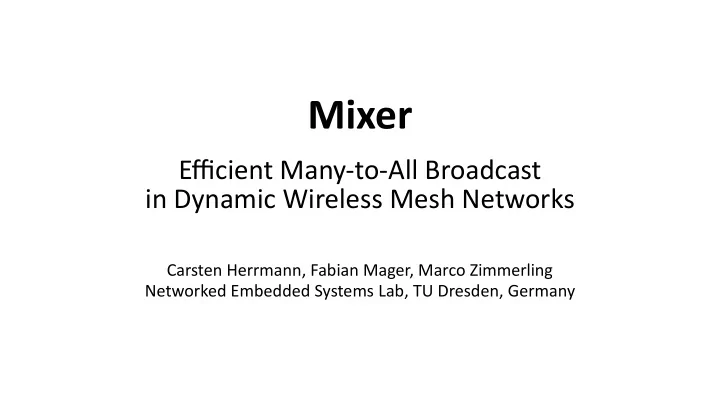

Mixer Effjcient Many-to-All Broadcast in Dynamic Wireless Mesh Networks Carsten Herrmann, Fabian Mager, Marco Zimmerling Networked Embedded Systems Lab, TU Dresden, Germany
Why Many-to-All Communication?
Why Many-to-All universal: ● can serve any possible traffjc patuern (one-to-one, one-to-many, all-to-all, etc.) fundamental for a growing number of emerging applicatjons and services: ● coordinatjon and distributed control in Cyber-Physical Systems – factory automatjon – collaboratjve agents, drone swarms – (I)IoT edge ● programming abstractjons (based on data replicatjon) ● fault tolerance mechanisms (based on state replicatjon) ● over-the-air programming / updates, ... 3
Requirements for Many-to-All ● fast (10…500 ms end-to-end) ● reliable ● support for dynamic mesh topologies ● support for adequate message sizes (tens of bytes) ● energy effjcient (weight, cost) 4 [1] Akerberg et al., Future research challenges in wireless sensor and actuator networks targetjng industrial automatjon, IEEE INDIN 2011
Current Solutjons ● Multj-Sink Routjng [1]: – degenerates under high network dynamics ● Sequentjal Flooding (S-Glossy) [2]: – suboptjmal scaling O(M · T) ● Pipelined Flooding [3]: – not universal (only one-to-all) – infeasible under high network dynamics [1] e.g. Motuola et al., MUSTER: Adaptjve Energy-Aware Multjsink Routjng in Wireless Sensor Networks, IEEE Transactjons on Mobile Computjng 2011 5 [2] e.g. Ferrari et al., Effjcient network fmooding and tjme synchronizatjon with Glossy, ACM/IEEE IPSN 2011 [3] e.g. Du et al., When Pipelines Meet Fountain: Fast Data Disseminatjon in Wireless Sensor Networks, ACM SenSys 2015
Our Contributjon Mixer , a new many-to-all broadcast primitjve for dynamic wireless mesh networks ● signifjcantly outperforms prior many-to-all solutjons, approaches order-optjmal scaling O(M + T) ● provides nearly perfect reliability despite signifjcant network dynamics ● supports the full spectrum from one-to-all to all-to-all communicatjon 6
Our Contributjon Mixer , a new many-to-all broadcast primitjve for dynamic wireless mesh networks ● signifjcantly outperforms prior many-to-all solutjons, Applicatjon approaches order-optjmal scaling O(M + T) ● provides nearly perfect reliability Higher Layer Protocol despite signifjcant network dynamics ● supports the full spectrum from one-to-all Mixer to all-to-all communicatjon Physical Layer 7
Our Contributjon init(1) mixer_init(node_id) mixer_write(index, *msg, size) init(2) mixer_arm(mode) mixer_start() mixer_read(index) init(3) implementatjon available as open source 8
Our Contributjon init(1) write(1,…) mixer_init(node_id) mixer_write(index, *msg, size) init(2) write(2,…) mixer_arm(mode) write(3,…) mixer_start() mixer_read(index) init(3) implementatjon available as open source 8
Our Contributjon init(1) write(1,…) arm() start() mixer_init(node_id) mixer_write(index, *msg, size) init(2) write(2,…) mixer_arm(mode) write(3,…) arm() start() mixer_start() mixer_read(index) init(3) arm() start() implementatjon available as open source 8
Our Contributjon init(1) write(1,…) arm() start() read(1) read(2) mixer_init(node_id) read(3) mixer_write(index, *msg, size) init(2) write(2,…) mixer_arm(mode) write(3,…) arm() start() mixer_start() read(1) read(2) read(3) mixer_read(index) init(3) arm() start() read(1) implementatjon available as open source read(2) read(3) 8
Ingredients of Mixer
Ingredients of Mixer Key Concepts Random Linear Network Coding (RLNC) ● → overlay fmoods Synchronous Transmissions ● → enable capture and spatjal reuse 10
Linear Network Coding task: disseminate Sequential Flooding Linear Network Coding 3 messages (S-Glossy) (example) slot 1 1 0 0 | 21 1 0 0 | 21 ... 1 0 0 | 21 1 1 0 | 43 0 1 0 | 22 0 1 1 | 45 0 1 0 | 22 0 0 1 | 23 ... 0 0 1 | 23 - slot 6 0 0 1 | 23 - robustness 1 packet 1 packet cost 6 slots 4 slots + computations 11
Sequentjal Flooding 12
Sequentjal Flooding 12
Sequentjal Flooding 12
Sequentjal Flooding 12
Sequentjal Flooding 12
Sequentjal Flooding 12
Sequentjal Flooding 12
Sequentjal Flooding 12
Sequentjal Flooding 12
Sequentjal Flooding 12
Mixer 13
Mixer 13
Mixer 13
Mixer 13
Mixer 13
Ingredients of Mixer Key Concepts Challenges Random Linear Network Coding (RLNC) When should a node send or listen? ● ● → overlay fmoods What should a node send (combine)? ● Synchronous Transmissions ● → enable capture and spatjal reuse Effjcient Architecture transport layer with sideload feature ● deliberate scheduling of (matrix) ● operatjons 14
Ingredients of Mixer Key Concepts Smart Policies / Features ("Spices") Random Linear Network Coding (RLNC) Semi-Coordinated Transmissions ● ● → overlay fmoods Explicit Innovatjon Forwarding ● Synchronous Transmissions ● Knowledge-based Startup Behavior ● → enable capture and spatjal reuse Actjve Requests ● Smart Shutdown ● Effjcient Architecture transport layer with sideload feature ● deliberate scheduling of (matrix) ● operatjons 14
Mixer in Actjon … 15
Evaluation
Setup ● implementatjon on TelosB – MSP430, 4 MHz, 10KB RAM, IEEE 802.15.4 – ARM port is in progress… ● extensive tests on – FlockLab (ETH Zürich, 27 nodes, 4 hops) – Indriya (NU Singapore, 94 nodes, 8 hops) 17
Experiments 18
Reliability 100% Mixer delivered all messages in all FlockLab and Indriya experiments 19
Experiments ● general performance: impact of – message size 20
Performance all-to-all Mixer outperforms S-Glossy by up to 3.8x 21
Experiments ● general performance: impact of – message size – number of messages – initjal message distributjon 22
Performance many-to-all Mixer is versatjle and scales well 23
Experiments ● general performance: impact of – message size – number of messages – initjal message distributjon ● impact of node failures ● impact of node mobility ● potentjal of faster CPUs and physical layers 24
Conclusion
Conclusion Mixer , a many-to-all broadcast primitjve ● designed for dynamic wireless mesh networks ● embeds RLNC and synchronous transmissions into an effjcient architecture and adds smart policies to make the combinatjon „spicy“ ● supports any initjal message distributjon, i.e., complete spectrum from one- to-all to all-to-all communicatjon patuerns Visit htups://mixer.nes-lab.org ➔ source code, tutorial projects, documentatjon, … ➔ TelosB (MSP430) available right now, ARM coming soon 26
Recommend
More recommend